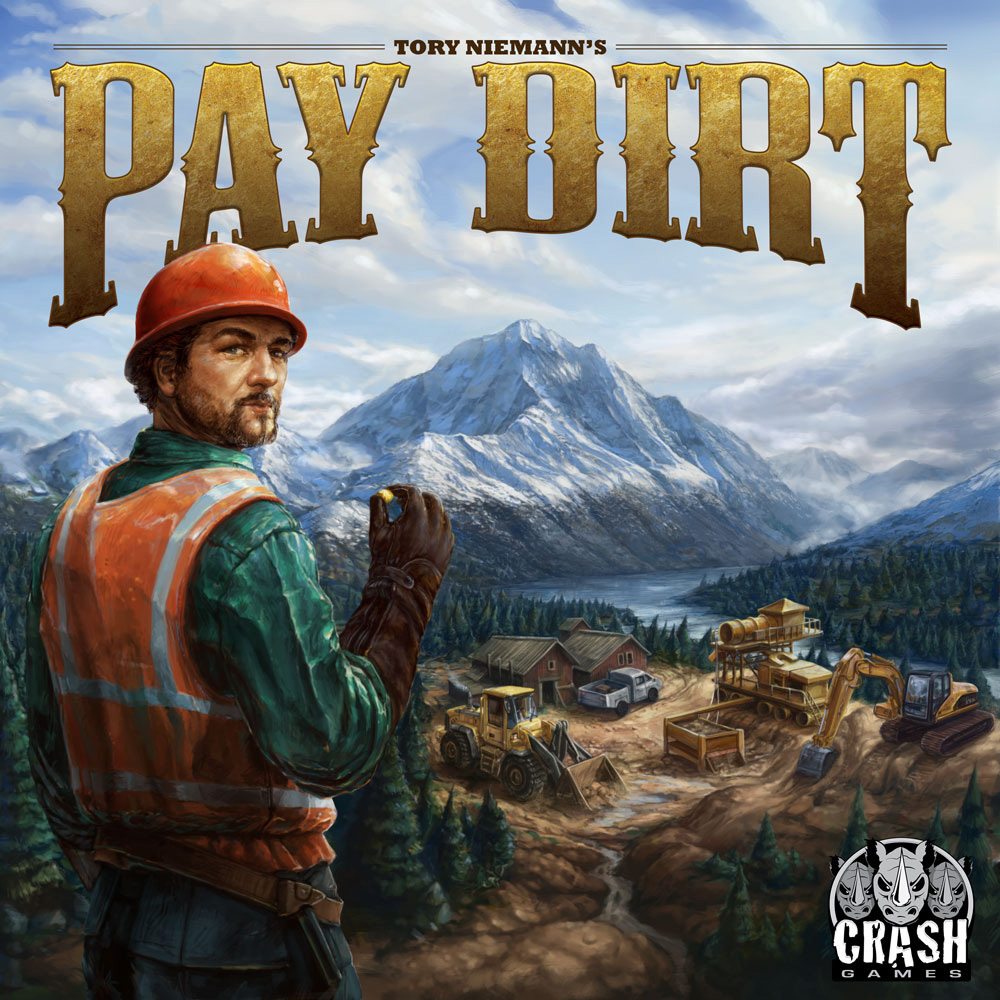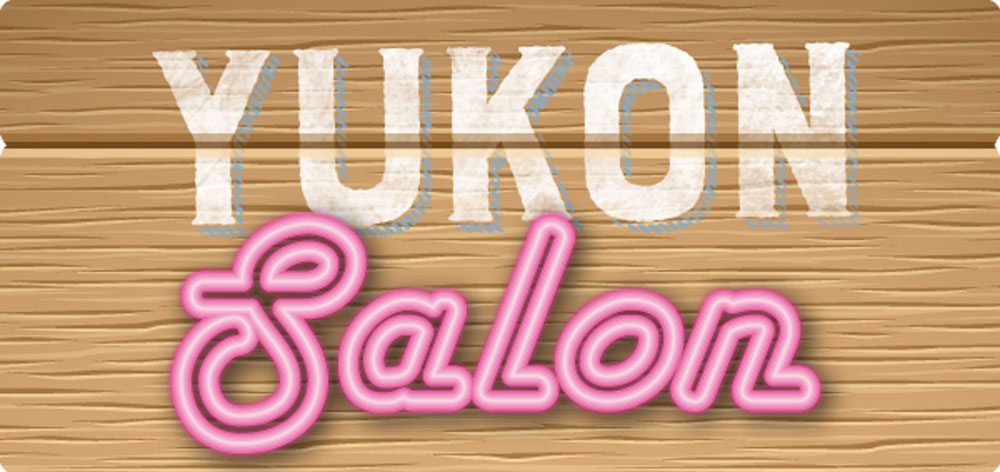Pay Dirt is a board game about mining for gold—but we’re not talking about ’49ers with pickaxes and pans here. This is modern-day mining, with excavators and bulldozers. And paperwork. (Well, just a little.)
At a glance: Pay Dirt is for 2 to 4 players, ages 13 and up, and takes about an hour and a half to play. The game is a combination of auction mechanics and worker placement, though in this game your workers don’t interfere with other players quite as much. The pledge level for the game is $50 on Kickstarter. Pay Dirt was designed by Tory Niemann, who also designed the popular Alien Frontiers, and will be published by Crash Games. For the ambitious, the Print and Play files are available for free so you can try out the game before pledging.
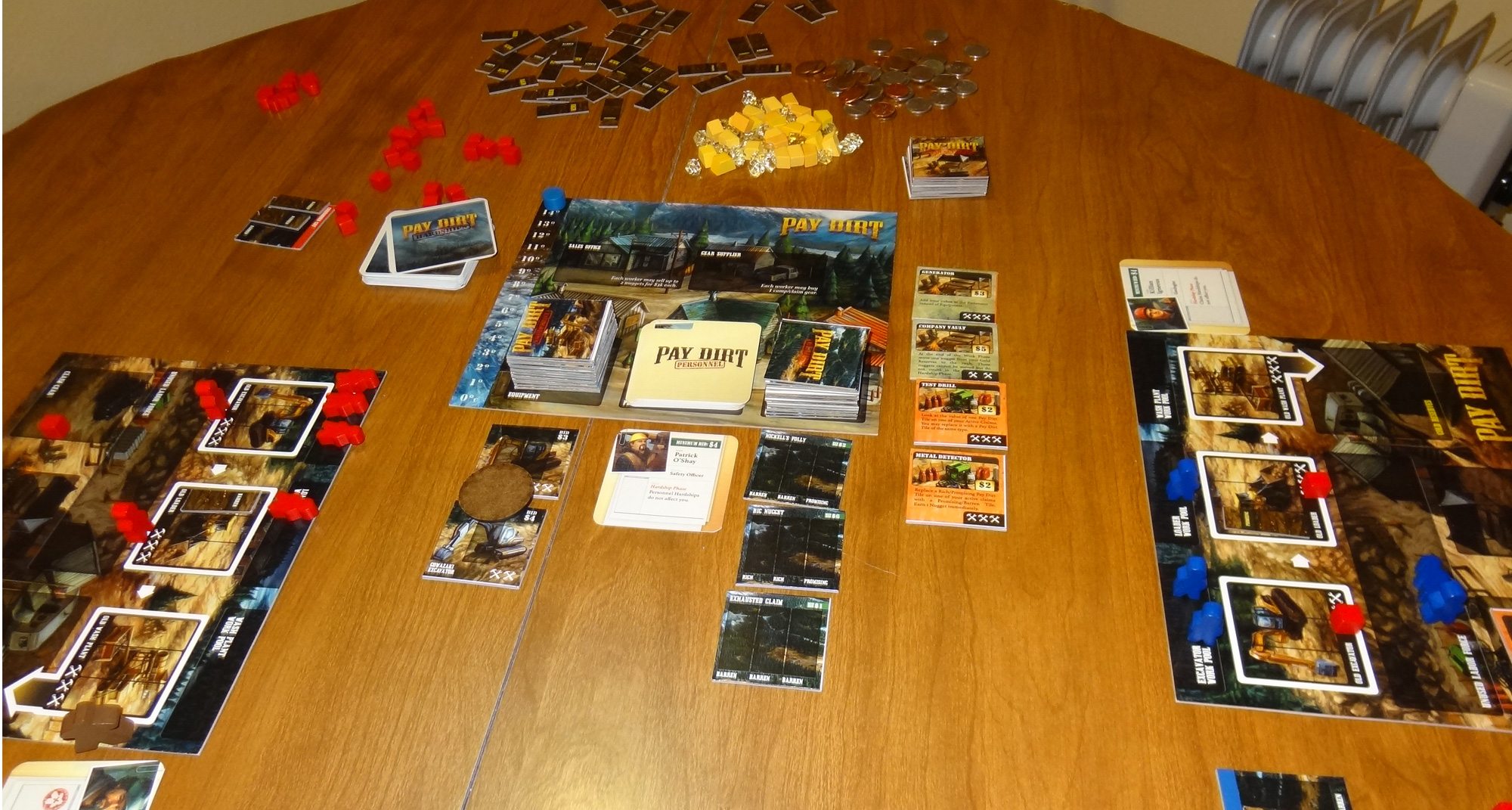
Components
The version I played is a playtesting prototype, so exact numbers are subject to change, but here’s roughly what will be included:
- 1 main board
- 4 player boards
- 18 Equipment tiles (6 each Excavators, Loaders, Wash Plants)
- 18 Personnel cards
- 18 Claim tiles
- 4 Greenhorn Claim tiles (1 per player color)
- 14 Gear tiles
- 44 Pay Dirt tiles (20 Barren, 12 Promising, 12 Rich)
- 50 Money tokens (30 $1k, 20 $3k)
- 48 Wear cubes
- 25 Gold Nuggets (worth 1 gold)
- 30 Gold Bars (worth 5 gold)
- 40 Worker meeples (10 each in 4 player colors)
- Head Miner token
- Auction token
- Temperature token
- 30 Hardship cards
The main board holds the auction items and has some spaces for workers to head to town. It also has a thermometer on one edge that serves as a game timer—when it hits 0°, the game is about to end.

The Pay Dirt tiles are small rectangles that have ranges of values. Barren tiles are worth 2 to 4 nuggets, Promising tiles are worth 3 to 5 nuggets, and Rich tiles are worth 4 to 6 nuggets. Claim tiles generally hold two or three Pay Dirt tiles. The player boards show spaces for your three processing machinery—excavators, loaders, and wash plants—each of which has three spaces for Pay Dirt. The Equipment tiles fit over the starting equipment on the player boards, and each has one to three slots for Pay Dirt.

There’s also space on the player board for one Camp Gear and one Claim Gear tile, your pool of worker meeples, your gold nuggets and bars, and areas to send your workers to use the equipment. The artwork on the boards is a more realistic style of illustration, like what you see on the box cover above, and the areas where things are placed mirror the locations of things in your camp.
How to play
The prototype rules for Pay Dirt are available here as a PDF, but here’s a run down of how the game works. The object of the game, as you may expect, is to accumulate the most gold before the temperature drops to freezing and the mining season is over.
Setup
Each player gets a player board, a Greenhorn Cut claim tile (with three Barren pay dirt tiles on it), five of the ten worker meeples in their color (the rest are set aside for now), and $9k. The starting player gets the Head Miner token. On the main board, you’ll put the shuffled stacks of Equipment, Personnel, and Claims, and then reveal three of each type below the board as the auction house. You’ll also shuffle the Gear tiles and reveal five of those nearby—this is the Gear Supplier. Finally, the Hardship cards are shuffled and placed nearby, and the temperature starts at 15°.
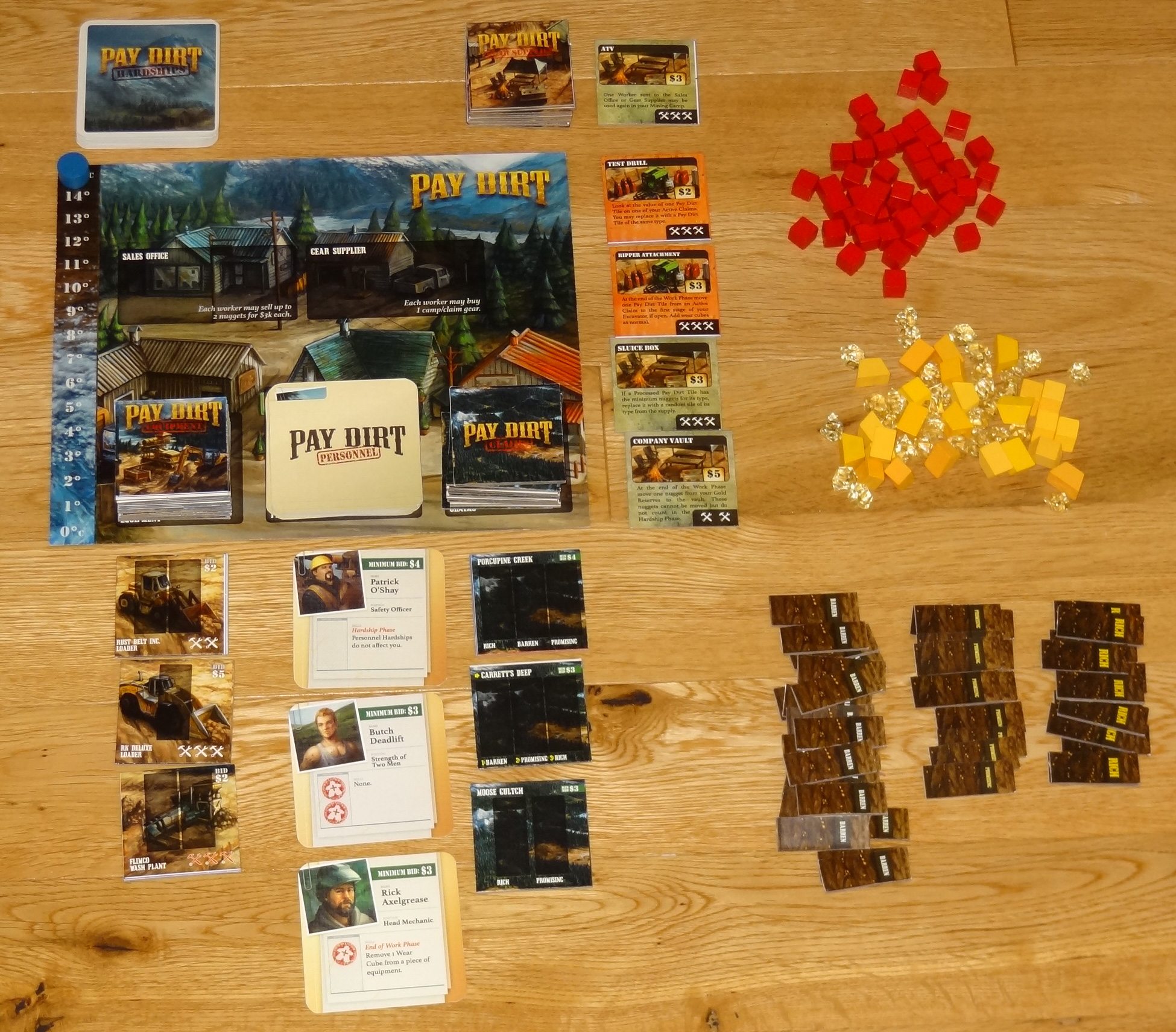
Turn order
Each round has four phases: Auction, Work, Hardship, and Income.
During the Auction phase, players will bid on Equipment, Personnel, and Claims. Purchased Equipment gets placed into the correct spot on the player board, or can be used to repair wear on an existing piece of Equipment. Personnel are placed to the right of the board and offer various abilities—many of the Personnel cards also have meeple icons on them, which means you get to add some of those set-aside worker meeples to your labor force. Claims are placed to the left of your player board and filled with the appropriate pay dirt tiles.
The Work phase is where you assign all your workers to do things. Most of these will go on your own player board to process pay dirt and repair equipment, but you can also send some to town (the main board) to sell gold nuggets for cash or to buy Gear from the supplier.

When you assign workers to the equipment, they can move dirt from your Claims, through your Excavator, your Loader, and finally your Wash Plant to be processed into gold nuggets. Each step of the process requires one Worker, and each time a pay dirt tile enters a piece of Equipment, that Equipment gets a wear cube. If the wear cubes match the number of tool icons, then you can’t load any new pay dirt tiles there until you repair it. (You may, however, continue moving dirt tiles that are already present.) Each worker assigned to repair Equipment (or Gear) can remove two wear cubes from that item.
When you start off, each piece of equipment has three slots, so it takes 9 workers to get from start to finish. However, you can buy better Equipment that has fewer slots so it takes fewer workers to process. As soon as a pay dirt tile hits the last slot in the Wash Plant, you flip it over and exchange the tile for the appropriate number of gold nuggets.
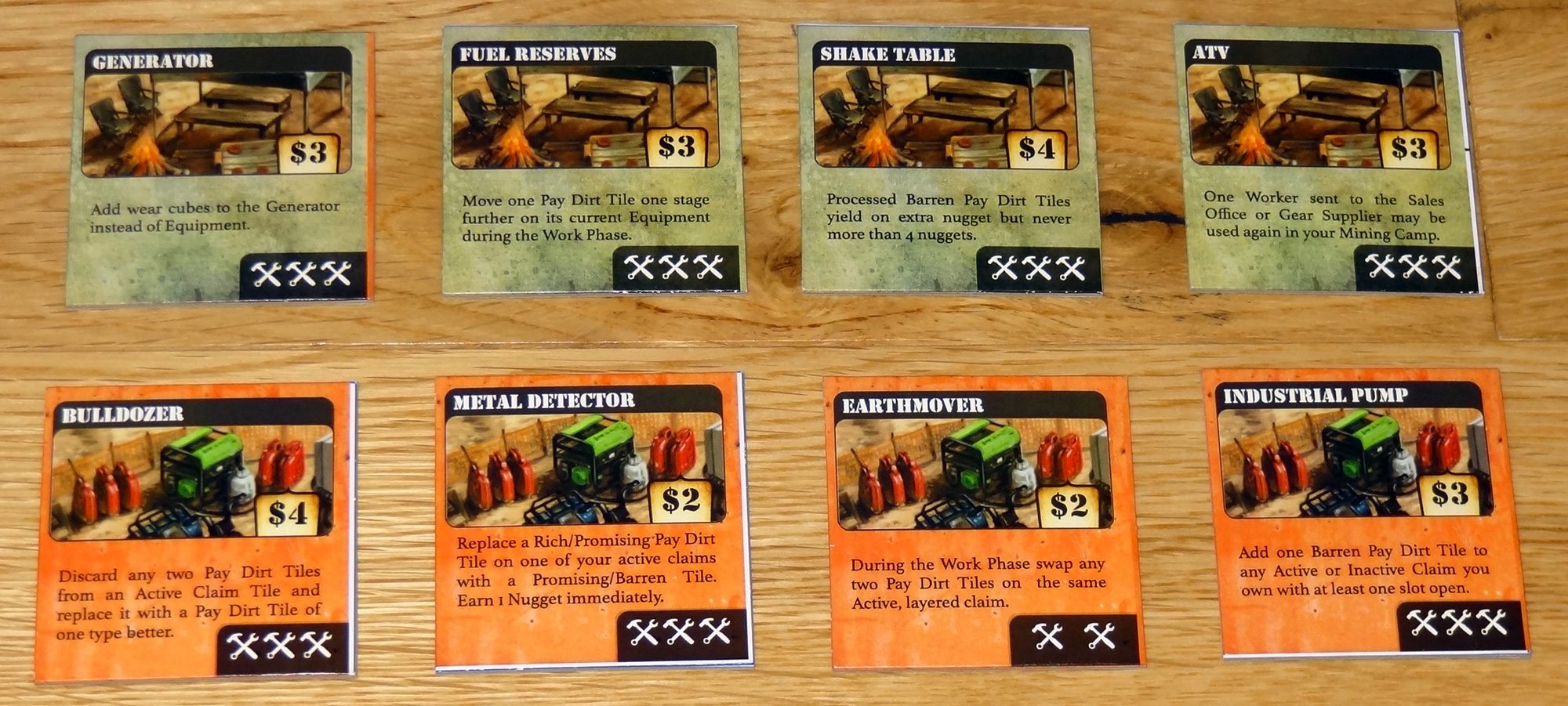
Claim Gear and Camp Gear don’t require workers to use, but you may only use each Gear once per round. When used, you add wear cubes to them, same as with Equipment. The various types of Gear can offer bonuses for you or ways to interfere with your opponents.
Since most of the Work phase is done on your own player board, everyone can do this simultaneously. The only thing that depends on turn order is buying from the Gear supplier, and that takes place clockwise starting with the Head Miner.

The Hardship phase is where bad things happen because mining is hard. Hardship cards can affect your Equipment, Personnel, or Claims, and there’s literally only one card in there that’s good when you draw it—because it does nothing. You draw enough cards so each player will get one, but the player with the least Gold gets to pick first, and the player with the most picks last. You could lose Personnel, have to pay extra to use Equipment, or—in the case of the “Misfiled Paperwork” card—lose the ability to bid on Claims for a round. The Hardship cards also have little clouds in the corner with -1° to -3° printed in them. The temperature drops by the number shown on whichever card the Head Miner gets.
Finally, during the Income phase, everyone takes $2k from the bank, and the auction items and Gear supplier are refilled.
If the temperature is at (or below) 0°, then there is one last round of play. There’s no Hardship or Income phase in the last round, but there is a chance to get a little more gold out of the last unprocessed pay dirt tile in your Equipment. Whoever has the most gold wins the game.

Verdict
I heard about Pay Dirt while I was at Gen Con last year, and got a quick glimpse but didn’t get a chance to sit down and play it at the time. I was curious about it, though, and I’m glad I’ve finally gotten a chance to see the game in its (nearly) complete form.
The rules are pretty straightforward and easy to pick up; the main part that can cause some confusion is in using your workers to move the dirt, but usually that only takes a round before you figure it out. And I’ll admit that I misread the auction rules—I was playing Power Grid style, where each player can only buy one item per round, but you can actually win multiple items per round if you have enough money.
I haven’t played a lot of games with auction mechanics, but they always make for some great player interaction—you never want to let somebody get away with a cheap bid, but you also don’t want to get stuck buying something you don’t want if they decide not to outbid you. In this case, there’s an added wrinkle because you can’t auction the same type of item consecutively. So if a Personnel card is up for auction and you really need an extra worker, you might have to bite the bullet and bid high because when it’s your turn to start an auction you’ll be left with Equipment or Claims.
There’s a nice balance in trying decide where to spend your money. Equipment makes it easier to process all your dirt more quickly, and more workers means you have more actions available. But none of that does you any good if you don’t have Claims with dirt tiles on them. You’ll also have to decide when it’s advantageous to sell gold at the sales office for cash: you’ll need something for the next round of bidding and the player with the least nuggets gets first pick of Hardship cards; on the other hand, at the end of the game gold is the only thing that matters, so having a big pile of cash won’t help you then.
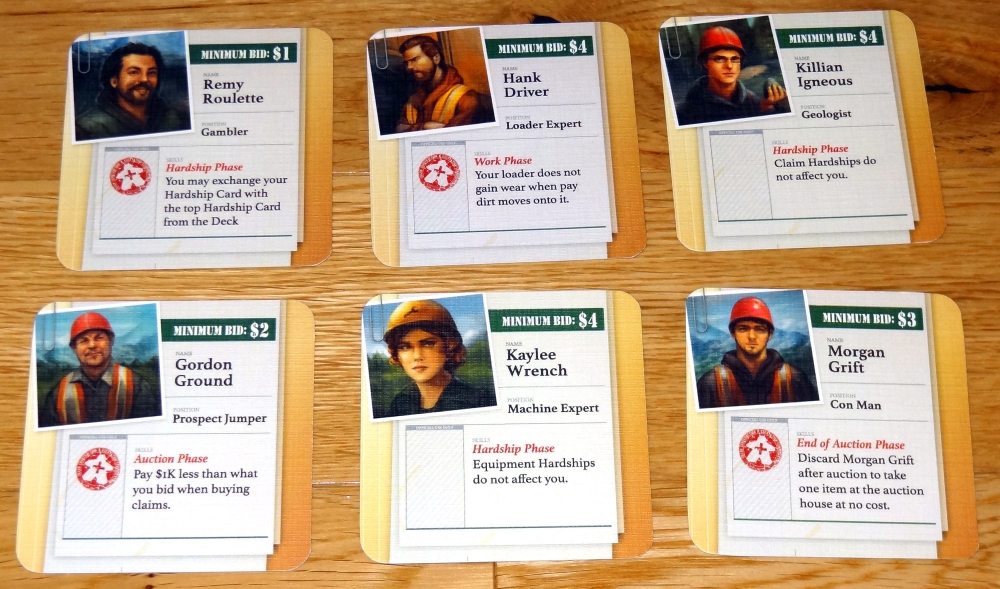
With all of the special abilities granted by Personnel and Gear, it can be a little overwhelming the first time you play and you’re learning what everything does, but it doesn’t take too long before you can decide what approach you’re going to take and focus on getting items that benefit your strategy.
The game can feel a bit fiddly at times, mostly because of all the dirt moving. You put workers on the equipment spots, then you move the dirt tiles, then you add wear cubes, then maybe you remove wear cubes because you have a worker who repairs things, then you trade in the dirt tile for nugget tokens, then you sell a nugget for money tokens… it’s a lot of moving things around. Since I’ve usually played the Work phase simultaneously, we just all have to assume that the other players are moving things accurately—and I guess if you’re playing with less-scrupulous people then maybe you want to keep them honest.
I liked the feel of the game—because the pay dirt tiles are kept face-down until you finish processing them (or unless you have Gear that lets you peek), it’s always a bit of a gamble how much any particular Claim will be worth in the end. There’s that bit of uncertainty—better technology can help you make better predictions or improve your results, but only up to a certain point.
The length of the game can be somewhat unpredictable, though that’s also partly within the control of the players. Since the temperature can drop 1° to 3° per round, the game could be over in as few as five rounds, or it could (theoretically, though not realistically) last fifteen rounds. (There are only nine 1° cards, but it’s possible for the Head Miner to keep getting those when the deck is reshuffled.) If you think you’re ahead, then it’s in your interest to give the Head Miner a high numbered Hardship card. On the other hand, if you want mining season to last just a little longer, it may be worth taking a worse Hardship for yourself in order to keep the temperatures up.
Overall, Pay Dirt is an intriguing game that lets you make the most of uncertainty. Processing dirt is done on your own board, but there’s plenty of player interaction in the auctions, in some of the Gear, and in jockeying for position so you don’t get stuck with terrible Hardship cards. (Just kidding: they’re all terrible but one, so you’re just trying to pick the least terrible.) The game is fairly fast-paced as long as players don’t get bogged down with analysis paralysis (which can be a problem). I think the age recommendation is about right: between the complexity of the game and some of the references (like the “Late Night Bender” Hardship card), I don’t think the game would be suitable for anyone much younger.
For more information, check out the Pay Dirt Kickstarter page.
Disclosure: A prototype was loaned to GeekDad for review purposes.

